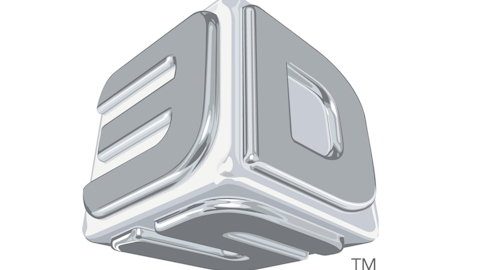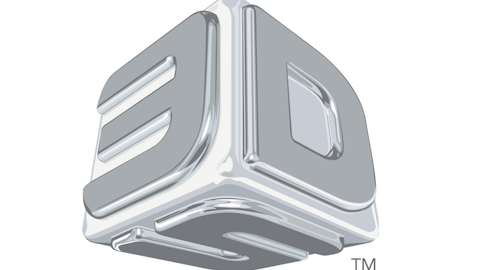Last week, I finally decided to purchase my first shares of additive manufacturing specialist 3D Systems Corporation (NYSE:DDD) for my personal portfolio.
It certainly wasn’t a hasty decision; I’ve kept the company in my sights for the better part of the last two years, and even initiated an outperform CAPScall on the stock last September.
While that call has outperformed the broader market by more than 12% so far, those of you who’ve kept track probably know 3D Systems Corporation (NYSE:DDD) has taken investors on one heck of a ride since then:
So why did I finally take the plunge? It surely wasn’t the valuation, especially considering 3D Systems Corporation (NYSE:DDD) was trading around 70 times trailing earnings even after falling more than 30% from the 52-week-high it had set less than three months ago. Though that pullback admittedly made my decision a little easier, it merely brought the price down from “absurd” to something closer to “terribly expensive.” Still, the stock looks much more palatable now that shares are trading at a much more respectable 24 times forward earnings estimates.
This, in part, highlights the fact that the real allure of 3D Systems Corporation (NYSE:DDD) lies in its future ability to play a central role in redefining manufacturing as we know it. Even so, many prospective investors remain skeptical as truly wide-scale adoption currently seems out of reach given 3-D printing’s relatively limited consumer utility.
On one hand, I suppose you can’t blame them, since many 3-D printed products find their place behind the scenes in niche markets like medical implants and custom parts for motorcycles, cars, and the aerospace industry.
To be sure, 3D Systems Corporation (NYSE:DDD) is one of only a few companies beginning to place significantly more focus on the consumer market with its Cube line of desktop printers. However, the devices are limited to using just two types of plastic printing materials, and they’ve only recently graduated to printing in up to three colors:

3D Systems’ CubeX Trio personal printer. Source: 3D Systems
Baby steps in 3-D printing
Big whoop, right? It’s nice to see a change from the same old monochrome trinkets, but why should anyone be excited about a gimmicky hobbyist printer which starts at around $1,300 and can only let us make trinkets?
To answer that question, remember what our fellow Fool Isaac Pino reminded us a few weeks ago: high-end production 3-D printers from companies like 3D Systems Corporation (NYSE:DDD), Stratasys, Ltd. (NASDAQ:SSYS), and ExOne Co (NASDAQ:XONE) are capable of using dozens of materials to print infinitely more complicated items including shoes, saws, guitar bodies, and other functioning tools with moving parts. Heck, 3-D bioprinting specialist Organovo Holdings Inc (OTCBB:ONVO) is currently working feverishly on perfecting the process of designing and creating functional human tissue which — putting inevitable regulatory hurdles for using the technology aside — could obviously change the health care world as we know it.
Then there’s iRobot Corporation (NASDAQ:IRBT), which filed a patent recently for what it’s calling a Robotic Fabricator, or a 3-D printer which can print and assemble a robot without the need for human interaction. While we likely won’t see this awesome invention implemented anytime soon, it also serves as another reminder of the industry’s potential.
Now 3D Systems isn’t directly involved in every one of the above-mentioned innovations, but remember that the steam propelling additive manufacturing in general has been building for decades. And 3D Systems, for its part, boasts the most comprehensive portfolio of 3-D printers out of any other company, especially after completing its merger last year with fellow industry leader Objet.
Foolish final thoughts
This doesn’t mean 3D Systems will be the only company to benefit in the space. To the contrary, I also own shares of iRobot Corporation (NASDAQ:IRBT) and fully intend to add Stratasys, Ltd. (NASDAQ:SSYS) to my portfolio down the road.
In the end, I’m convinced its only a matter of time until 3-D printing solidifies its place as a permanent fixture in our everyday lives. Unless some miraculous unforeseen event manages to change my opinion, I plan on holding shares of 3D Systems in my portfolio for decades to come.
The article Why I Finally Added 3D Systems to My Portfolio originally appeared on Fool.com.
Fool contributor Steve Symington owns shares of iRobot and 3D Systems. The Motley Fool recommends 3D Systems, iRobot, and Stratasys. The Motley Fool owns shares of 3D Systems and Stratasys and has the following options: Short Jan 2014 $36 Calls on 3D Systems and Short Jan 2014 $20 Puts on 3D Systems.
Copyright © 1995 – 2013 The Motley Fool, LLC. All rights reserved. The Motley Fool has a disclosure policy.
Over the past few months, few stocks have divided investors as much as Research in Motion Ltd (NASDAQ:BBRY). Since the company changed its name from Research in Motion Ltd (NASDAQ:BBRY) to BlackBerry and revealed its Z10 smartphone, shares have been on a roller coaster with swings of five percent or more not uncommon. While CEO Thorsten Heins did mention general information about sales, no definitive figures were to be announced until March 28 when the company held its Q4 earnings call. Questions would be answered, Research in Motion Ltd (NASDAQ:BBRY)’s future would be determined, and either longs or shorts would profit immensely.

BlackBerry battle
Leading up to the earnings call, analysts had all put in their estimates for Research in Motion Ltd (NASDAQ:BBRY)’s Q4 performance. Estimates for BlackBerry Z10 sales were generally around one million units, give or take a few hundred thousand. Of course, analysts had set various price targets ranging from $7 to $22 per share. These were usually twelve month targets, but most analysts at least partially based them on the Q4 results. However, there was one thing analysts were in agreement on; Research in Motion Ltd (NASDAQ:BBRY) would post a quarterly loss.
The results are in
This article is being written on the weekend following the Q4 earnings release, a time when Research in Motion Ltd (NASDAQ:BBRY)’s future was supposed to be made clearer. With respect to results, one million Z10s were sold which missed, hit, or exceeded expectations, depending on who you talk to. Total subscribers decreased more than expected and sales of older BlackBerry devices were slightly short of expectations. But the biggest surprise was Research in Motion Ltd (NASDAQ:BBRY) posting a profitable quarter when almost no one expected them to do so.
Shares off to the races
With such a critical earnings call, Research in Motion shares were expected to be volatile on March 28 swinging sharply higher as short sellers of the stock get squeezed, or falling hard as selling pressure hits and short sellers dig in. As it turned out, shares rose as much as ten percent before giving up their gains later in the day and finishing down just less than one percent. For a critical earnings call, a final price change of less than one percent is insignificant. It appears in the end, both sides of the Research in Motion/BlackBerry debate stuck to their positions and the broader market saw no reason to strongly move the stock in one direction or the other.
The real news
Both sides now seem to be gearing up for the Q1 2013 earnings call as quickly as politicians are gearing up for the 2016 election. Shorts, for the most part, are still short and longs, for the most part, are still long. BlackBerry still faces the same challenges it did yesterday, a smartphone world where Google Inc (NASDAQ:GOOG)‘s Android and Apple Inc. (NASDAQ:AAPL)‘s iOS have created a near duopoly over smartphone sales. Additionally, Microsoft Corporation (NASDAQ:MSFT) is working hard to win the third place slot that BlackBerry is trying to grab onto as a foothold to begin growing again.
With a steep share price decline since hitting highs of $700 per share, Apple is now being looked upon as a value stock by many. The basis for this argument centers around Apple’s P/E ratio that has fallen to the single digits. In contrast, those who view BlackBerry/Research in Motion as a value stock look toward tangible book value and the company’s patent portfolio due to BlackBerry’s low price to tangible book and lack of current earnings. With a P/E ratio more than twice that of Apple, Google Inc (NASDAQ:GOOG) has moved into nearly every aspect of our lives and has become a common verb. While Apple Inc. (NASDAQ:AAPL) shares slipped as investors feared Apple was no longer innovating, Google is still gaining ground and is fighting with the $800 level. But, for Google, smartphones are just part of the business. With everything from Google Glasses to self-driving cars, this search engine turned giant hopes to make their smartphones just part of your total Google experience.
However, quick success for BlackBerry in the smartphone space is more critical for the Canadian smartphone and services company than for many of its rivals. An occasional miss by Google or Apple will not cause the same threaten these companies in the same way as it would affect BlackBerry. While all three companies offer services as well as hardware, both Google and Apple have a far greater number of up to date products than BlackBerry which is trying to roll out its phones as fast as it can so as not to fall any further behind in the smartphone space. Analysts are also closely monitoring Z10 sales, and soon Q10 sales, and negative reports from them or BlackBerry itself could cause a stock panic as investors run for the exits. Even if this panic is not justified, the effects could snowball dragging down the share price to far lower levels.
This is not to say BlackBerry/Research in Motion cannot succeed. Initial sales seem positive and the figure of one million shows there is still demand amongst BlackBerry fans (CrackBerrys) for the company’s comeback phone. In a less than a month, BlackBerry expects to launch the Q10 in the United Kingdom before expanding sales into the United States shortly thereafter. With a physical keyboard, many CrackBerrys are passing on the Z10 and waiting for the Q10 instead. Only after this phone’s release will we have a better idea as to how many BlackBerry users are continuing with the brand.
Keep moving
With so many investors looking toward the Q1 2013 earnings call, I am even more looking forward to the Q2 2013 earnings call where we can get a glimpse of Q10 sales as well. Without question, the Q4 2012 earnings report is incomplete with respect to showing BlackBerry’s future potential. U.S. sales did not make it into the report and the Z10 was not available for much of the quarter. And with no conclusive findings, shares did not move dramatically, even with this highly volatile stock. As the BlackBerry/Research in Motion slogan goes, Keep Moving, we will just have to wait for the Q1 and Q2 earnings reports to see who gets to profit from this BlackBerry battle.
Alexander MacLennan owns shares of BlackBerry. The Motley Fool recommends Apple and Google. The Motley Fool owns shares of Apple and Google.



